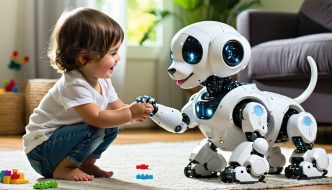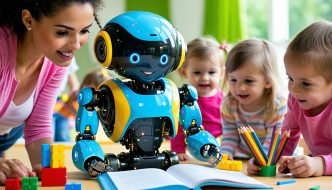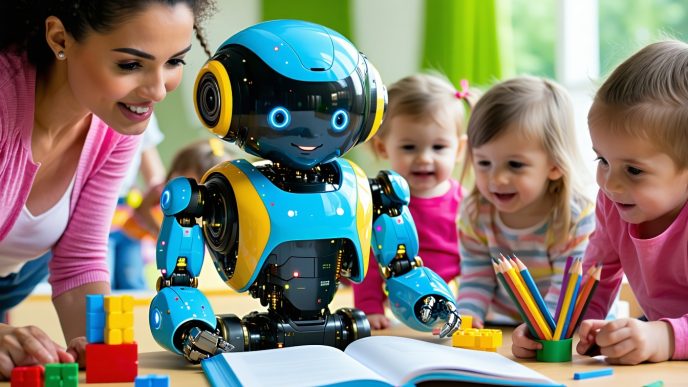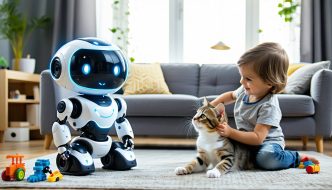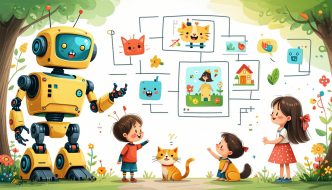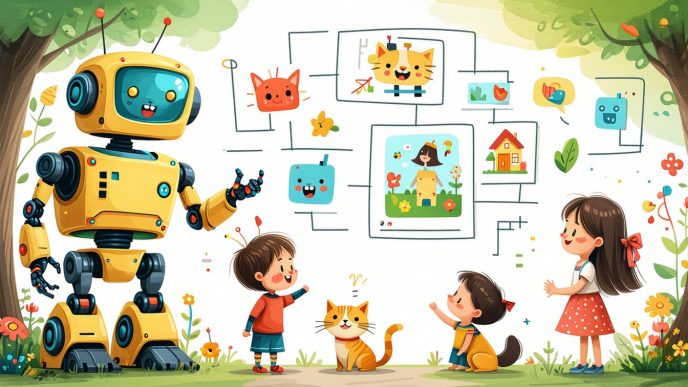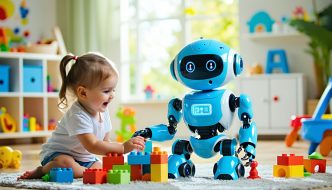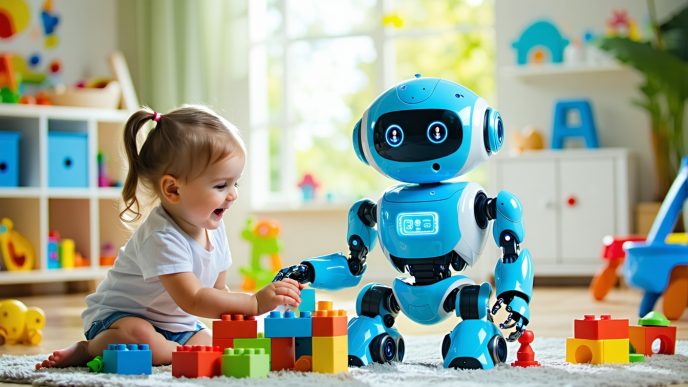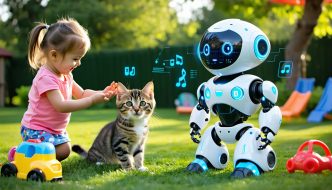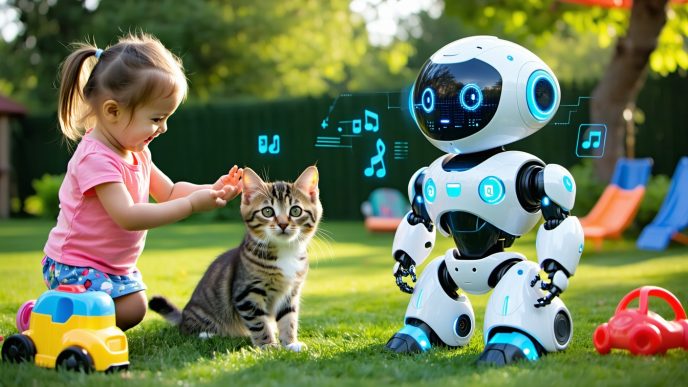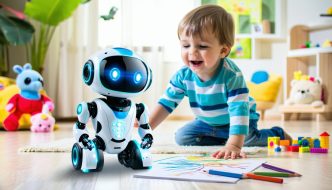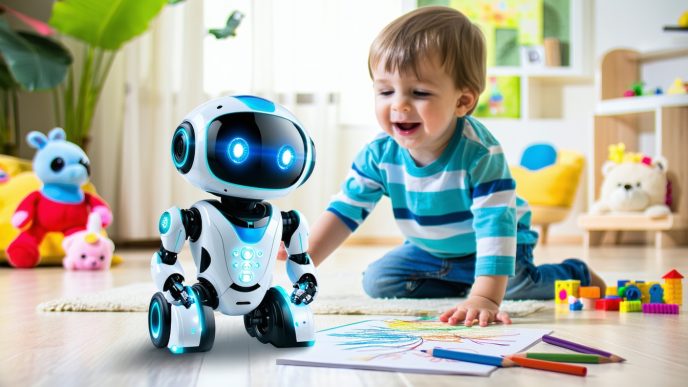Exploring Robotics in Family Settings
The Use of Robots in Interactions with Kids and Pets
Robots are becoming increasingly integrated into family environments, serving as valuable tools for engaging with children and pets. They can provide interactive play, educational experiences, and companionship. The use of robots in these interactions can vary significantly, from playing games with kids to providing entertainment for pets while owners are away.
Robots can be programmed to respond to children’s questions and needs, making them not just companions but also educators. This technology is capable of engaging children in learning activities, such as teaching safety protocols or fundamental skills. For insights into how robots can impart safety lessons to children, visit our article on robots teaching safety to kids.
In addition to interacting with children, robots can also play a crucial role in pet care. They can be used for monitoring pets’ activities and health while their owners are not home. Some robots facilitate playtime through interactive games designed specifically for pets. For more information on how robots assist in monitoring pets, refer to our article on robots monitoring pets at home.
Benefits of Robots in Enhancing Child and Pet Experiences
Incorporating robots into family life offers several key benefits for both children and pets. The following table outlines these advantages:
| Benefit | Description |
|---|---|
| Enhanced Learning | Robots engage children in educational activities, making learning enjoyable and interactive. They can introduce concepts such as math, language, and safety. |
| Companionship | Robots provide companionship to children, promoting social interaction and emotional bonding. Exposing kids to robots can help them develop empathy and relational skills. Refer to our article on emotional bonding with robots for further discussion. |
| Physical Activity | Interactive robots encourage movement, whether in games or activities designed to keep pets active. This promotes healthier lifestyles for both children and pets. |
| Safety Monitoring | Many robots are equipped with features that allow them to monitor surroundings, ensuring children’s safety while they play or interact with their pets. Explore more about these aspects in our article on safety features for kids and pets in robots. |
| Entertainment | Robots can keep pets entertained and stimulated, reducing anxiety and unwanted behaviors when owners are away. Check out our guide to the latest robot pet toys for more ideas. |
The diverse uses of robots in family environments not only enhance the experiences of children and pets but also lay the foundation for innovative future interactions.
Overall, the integration of robotic technology in family settings presents a multitude of opportunities for engaging, educating, and entertaining children and pets alike. Families interested in exploring these advantages can benefit from understanding the various ways robots can interact with their loved ones. For a look into what the future holds for robotics in family life, visit our article on the future of robot interactions with children and pets.
Safety Measures in Child and Pet Interactions with Robots
When integrating robots into family life, particularly in contexts involving children and pets, ensuring safety is paramount. This section highlights key design features that promote secure engagement, as well as the programming considerations that prioritize safety.
Design Features Ensuring Safe Engagement
Robots designed for interactions with children and pets typically incorporate various design elements intended to enhance safety. These features are essential to prevent accidents and ensure positive experiences.
| Design Feature | Description |
|---|---|
| Soft Edges | Rounded corners and soft materials minimize injury risks. |
| Weight and Stability | A low center of gravity helps prevent tipping during interactions. |
| Anti-Collision Sensors | Sensors detect obstacles and stop movement to avoid accidents. |
| Engaging Visuals and Sounds | Attractive designs and sounds can help divert attention safely. |
| Size Appropriateness | Heights and dimensions are tailored for children and pets. |
These design elements contribute to creating a safe environment for children and pets when interacting with robots. Additional information on safety features can be found in our article on safety features for kids and pets in robots.
Programming for Child and Pet Safety
Programming is another critical aspect of ensuring that robots function safely around children and pets. Key programming features are employed to monitor interactions and respond appropriately.
| Programming Feature | Description |
|---|---|
| Behavior Recognition | Robots can respond to cues from children and pets, adapting their actions accordingly. |
| Limited Movement Range | Robots can be programmed to operate within defined zones, ensuring safety during play. |
| Emergency Stop Mechanism | A quick-stop feature allows caregivers to halt robot activity immediately if necessary. |
| Positive Reinforcement Protocols | Programming encourages beneficial interactions instead of negative behaviors. |
| Monitoring Capabilities | Certain robots provide activity tracking for pets and kids, assisting caregivers in supervision. For examples, visit our article on robot activity tracking for pets and kids. |
By combining innovative design features with thoughtful programming, robots can safely engage with children and pets, providing valuable experiences that contribute to learning and companionship. Parents and families can explore more about the capabilities of robots as play companions in our article on robots as play companions for children and learn about pet monitoring systems at home in robots monitoring pets at home.
Robots and Child Development
Integrating robots into family environments can positively influence child development. These machines serve various functions that can enhance learning and provide entertainment while ensuring safety for both children and pets.
Educational and Entertaining Aspects
Robots can act as both educational tools and sources of entertainment for children. They can teach fundamental skills such as problem-solving, creativity, and social interaction. For instance, interactive robots can guide kids through games that encourage critical thinking or engage them in storytelling activities that enhance language development.
| Educational Benefits | Entertaining Features |
|---|---|
| Enhances critical thinking skills | Interactive play companions |
| Encourages creativity and imagination | Game-based learning activities |
| Teaches basic programming concepts | Storytelling and music |
| Promotes social skills through group activities | Personalized interaction |
The combination of education and fun can create a balanced learning experience. For deeper insights on how robots can serve as play companions, refer to our article on robots as play companions for children.
Monitoring and Supervision Roles
Robots can also play a vital role in monitoring and supervising children. Equipped with sensors and cameras, these devices can track activities, ensuring that kids are safe during playtime. This supervision adds an additional layer of security, enabling parents to engage in other tasks while being assured that their children are in a safe environment.
| Monitoring Features | Supervision Benefits |
|---|---|
| Activity tracking through sensors | Peace of mind for parents |
| Real-time alerts in case of unusual behavior | Allows parents to multitask effectively |
| Remote access for monitoring from a distance | Supports independence while ensuring safety |
Using robots for such roles can foster a sense of responsibility in children, teaching them boundaries and safety protocols. Explore how robots also contribute to pet monitoring by checking our article on robots monitoring pets at home.
Incorporating robots into daily life offers an innovative approach to enriching child development while maintaining a safe atmosphere within the household.
Robot Interactions with Pets
In the realm of family life, integrating robots into interactions with pets can provide both entertainment and support for pet owners. Understanding how these technologies can benefit pets is essential for responsible and effective use.
Understanding Pet Behavior
For robots to engage effectively with pets, it is crucial to comprehend common pet behaviors. Different animals exhibit various responses to new stimuli, including machines. Below is a summary of some typical canine and feline behaviors when encountering robots.
| Pet Type | Common Behaviors | Response to Robots |
|---|---|---|
| Dogs | Barking, sniffing, approaching | Often curious, may try to play |
| Cats | Cautious, hiding, playful swatting | Generally indifferent, may engage if intrigued |
When introducing robots that interact with pets, understanding these behaviors allows for a more enriching experience. For instance, a robot designed to mimic play can engage dogs’ natural hunting instincts while providing safe engagement. Parents can explore articles like robots as play companions for children to see how such interactions can benefit both kids and pets.
Incorporating Robotics into Pet Care
Robots can assist significantly in pet care, from playful interactions to monitoring health. Below are several applications where robotics can enhance pet care routines.
| Application | Description | Benefits |
|---|---|---|
| Robot Pet Toys | Interactive toys that engage pets through movement and sounds | Encourages play, reduces boredom |
| Monitoring Robots | Devices that watch over pets while owners are away | Provide peace of mind by tracking pet activity |
| Feeding Robots | Automated feeders that schedule meals for pets | Ensures regular feeding and manages portions |
These robotic innovations not only support pet care but also offer families a way to balance responsibilities effectively. Combining technology with pet care routines encourages a harmonious living environment for both pets and family members.
To learn more about how robots can monitor pets at home, refer to our article on robots monitoring pets at home. Furthermore, understanding the potential for robot activity tracking for pets and kids allows families to supervise their children and pets seamlessly.
Best Practices for Introducing Robots to Kids and Pets
Integrating robots into a household with children and pets requires a thoughtful approach to ensure safe and positive interactions. The following best practices can help families navigate this process effectively.
Gradual Introduction and Monitoring
Introducing robots gradually is essential for allowing kids and pets to adjust to the new presence in their environment. Parents should consider the following steps:
-
Start Slow: Begin by activating the robot in a controlled setting. Observe how children and pets respond to the robot before allowing more freedom in interactions.
-
Supervised Interactions: Always supervise the initial interactions between robots and family members. This ensures that any concerns can be addressed quickly.
-
Incremental Exposure: Gradually increase the length and complexity of interactions. This helps children and pets build confidence and comfort with the robot.
-
Monitor Reactions: Keep an eye on body language and emotional reactions from both children and pets. A positive response demonstrates readiness for further engagement.
These steps will help in fostering familiarity while maintaining a secure environment.
Setting Boundaries and Rules
Establishing clear boundaries and rules around robot interactions is crucial for ensuring the safety of both kids and pets. Consider these guidelines:
-
Designate Robot Time: Set specific times during which interaction with the robot is encouraged. This helps children and pets understand when the robot is part of their activities.
-
Limit Access: Determine areas where the robot can or cannot go. For example, it may be best to keep the robot out of bedrooms to ensure uninterrupted rest.
-
Teach Respectful Interactions: Guide children on how to approach and interact with the robot. Including lessons on appropriate behavior will help promote positive experiences. For example, instructing kids to gently touch or talk to the robot can foster respectful engagement.
-
Involve Kids in Monitoring: Encourage children to share their experiences with the robot. This not only promotes emotional bonding but also helps them take ownership of the relationship. Explore more about this in our article on emotional bonding with robots.
By setting boundaries and rules, families can ensure that the child and pet interaction with robots remains enjoyable and safe. For additional insights on optimizing robot experiences, check articles on robots as play companions for children and robots monitoring pets at home.
Future Perspectives on Robotics in Family Life
The role of robotics in family settings is evolving, particularly in enhancing interactions between children, pets, and smart technology. This section explores the potential growth in robot-assisted childcare and emerging trends in robotics for pet interaction.
Potential Growth in Robot-Assisted Childcare
As technology advances, the integration of robots into childcare settings is expected to expand significantly. Research indicates that parents are increasingly interested in using robotics to support their children’s education, safety, and entertainment. Here are some anticipated trends in this area:
| Trend | Description |
|---|---|
| Increased Educational Roles | Robots may be used as interactive teaching tools to engage children in learning concepts, such as math and reading. They could also facilitate lessons on safety and social interactions, as seen in articles about robots teaching safety to kids. |
| Enhanced Monitoring Capabilities | Robots might serve as effective monitors for children, alerting caregivers to any potential dangers while ensuring kids are safe. The ability to provide real-time data through robot activity tracking for pets and kids could enhance parental peace of mind. |
This growth in usage reflects a shift towards embracing technology as a supportive tool in caregiving, with the ultimate goal of improving developmental outcomes for children.
Emerging Trends in Pet-Interactive Robotics
Similarly, the field of robotics is advancing in ways that enhance the relationship between pets and their owners. The following trends highlight the growing opportunities for incorporating robots into pet care:
| Trend | Description |
|---|---|
| Innovative Pet Toys | Robotics offers a variety of engaging solutions for pets, such as automated toys that can entertain pets while their owners are away. Options like robot pet toys can keep pets active and stimulated. |
| Comprehensive Pet Monitoring Systems | With advancements in sensors and machine learning, robots can now monitor pet behaviors, health, and safety. This capability is reflected in articles on robots monitoring pets at home, ensuring that pets receive adequate attention and care. |
These trends signal a positive evolution in how pets are integrated into family life, fostering deeper emotional bonds, as discussed in emotional bonding with robots.
The intersection of robotics with family dynamics promises thrilling developments that can enhance daily interactions and enrich the lives of both children and pets. As technology continues to grow, one can expect more innovative solutions that cater to the unique needs of families.

